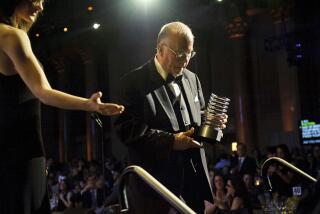Chasing the Holy Grail of Graphics
- Share via
SEATTLE — With his shaggy sideburns, rumpled clothes and hip-length black ponytail, James Kajiya looks more like a mystic than a computer visionary.
But Kajiya, Microsoft’s 47-year-old graphics guru, is pioneering new approaches to putting images on computer, and he thinks they’ll help transform the role of the personal computer.
He believes the computer, which evolved 20 years ago from a programming tool into a personal productivity tool, is now on its way to becoming a device that makes complex information as accessible as television.
Presenting the information in an engaging and easily understood way can best be done by a person--that’s how TV uses news reporters, for example--so one solution might be to display human emotion on the screen in the form of a human face.
“The face has an infinite variety of expressions. How do you encode and represent that information?” Kajiya asks.
He won’t answer his own question--”I can’t talk about that”--but he does say that the new medium will be a form of video. Not the video we know of today, but a new hybrid of photographed and computer-generated 2-D and 3-D images, sound, text and other information--all of which can be manipulated by the computer.
“The melding of TV and PC is going to change each of those disciplines forever in ways that are profound,” Kajiya says.
It was to shape this evolution that Kajiya left the California Institute of Technology three years ago to build Microsoft’s graphics team. He now heads a prolific group of 12 researchers. Last year 10 of the 50 papers presented at Siggraph came from Kajiya’s team at Microsoft.
Kajiya’s first goal at Microsoft was to make personal computers a more effective vehicle for displaying graphics. He designed a system that would use one-sixtieth of the processing power of traditional graphics machines by only redrawing parts of an animated image that change, rather than redrawing the whole image.
The technology, called Talisman, was unveiled at Siggraph last year. The trend toward developing graphics software for PCs is already transforming computing.
The new generation of PCs using Talisman, says Kajiya, will bring even greater change, including a 3-D Windows interface that would be the first major redesign of the PC interface since Xerox designed the “windows” approach in the early 1970s.
The problem is that computer screens are getting crowded, and people have trouble finding what they want on their computer or on the Web. But in a 3-D world, programmers can take advantage of the human mind’s strength in dealing with spatial relationships, something called psychophysics.
A familiar 3-D object such as a desk could be very tiny on the screen but appear much larger in the mind’s eye because of its familiarity. Because objects on a 3-D screen get larger as you move toward them, finding a file tucked away in a drawer on a desk would be easy even if the drawer is initially too small to see.
But integrating 3-D into the personal computer is only a “baby step” toward where Kajiya really wants to go. The Holy Grail, he believes, is video.
Kajiya figures that huge advances in hard-disk drives in the next three years will make computers capable of storing 100 gigabytes of information--50 times what most computers store today. That would allow 55 hours of digital video.
The true revolutionary potential of digital television, he says, will occur when it becomes as easy to portray and manipulate images in video form as it is today to manipulate text. With such information, photographed images added to a video could be designed to automatically cast the right shadows on their computer generated landscapes, for example.
Someday, for example, you may be able to look at what is behind the tree on a television screen by simply moving your head a few inches.
Or consider video telephones. They’ve never been very successful, Kajiya believes, because they don’t do a good job at picking up gestures and other clues that add enormously to the process of communicating.
Kajiya says the melding of TV and computers could solve that problem, though he refuses to say just how. Stay tuned. Kajiya plans to present his approach to solving many of these problems in a paper at Siggraph next year.
*
Leslie Helm can be reached via e-mail at leslie.helm@latimes.com




